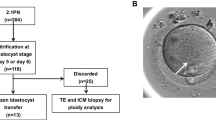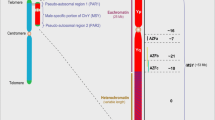Summary
Studies on testicular histology and meiosis were carried out by the use of light and electron microscopy in an 18-year-old Down's syndrome male in an attempt to follow the fate of the extra chromosome 21 and to evaluate the effects of this condition on spermatogenesis and the reproductive functions. The histological changes in the testes corresponded to spermatogenic arrest. Electron microscopic whole-mount spreadings of meiotic cells in the pachytene stage showed that in most nuclei an extra chromosome 21 was not detectable. Only in a small number of nuclei, univalents or trivalents with segmental pairing structures of an extra chromosome could be discovered. In contrast, the great majority of (C-banded) diakinesis figures showed the presence of a supernumerary G (no. 21) chromosome. The absence of a traceable extra chromosome 21 in most pachytene cells is explained by the assumption that it is intimately connected with and hidden in the sex vesicle, whose complex structure does not allow the identification of single elements. Strong support for this assumption is seen (a) in the general tendency of narrow spatial association of unpaired segments with the XY complex and (b) in close structural similarities occurring between univalents or nonsynapsed segments of trivalents and the nonpaired segments of the sex chromosomes. It is suggested that the association or connection of an extra chromosome with the XY complex during pachytene interferes with the phenomenon of X inactivation. In animal systems such abnormal interference is related with spermatogenic breakdown and, in a general way, with male hybrid type sterility. So far, the range of sterility vs. fertility in cases of male Down's syndrome is not yet fully clear, but it appears that impairment of fertility, and sterility are most frequent. If so, it is proposed that the effect of the trisomy 21 condition on spermatogenesis (and fertility) is a consequence of the behavior of the extra chromosome in the meiotic prophase.
Similar content being viewed by others
References
Bloom SE, Goodpasture C (1976) An improved technique for selective silver staining of nucleolar organizer regions in human chromosomes. Hum Genet 34:199–206
de Boer P, Branje HEB (1979) Association of the extra chromosome of tertiary trisomic male mice with the sex chromosomes during first meiotic prophase and its significance for impairment of spermatogenesis. Chromosoma 73:369–379
Chandley AC (1982) A pachytene analysis of two male-fertile paracentric inversions in chromosome 1 of the mouse and in the male-sterile double heterozygote. Chromosoma 85:127–135
Coerdt W, Rehder H, Gausmann I, Johannisson R, Gropp A (in preparation) Quantitative histology of human fetal testes in chromosomal diseases
Counce SJ, Meyer GF (1973) Differentiation of the synaptonemal complex and the kinetochore in Locusta spermatocytes studied by whole mount electron microscopy. Chromosoma 44:231–253
Evans EP, Breckon G, Ford CE (1964) An air-drying method for meiotic preparations from mammalian testes. Cytogenetics 3:289–294
Finch RA, Böök JA, Finley WH, Finley SC, Tucker CC (1966) Meiosis in trisomic Down's syndrome. Ala J Med Sci 3:117–120
Forejt J (1982) X-Y involvement in male sterility caused by autosome translocations — a hypothesis. In: Crosignani PG, Rubin BL (eds) Serono Clinical Colloquia on Reproduction 3. Genetic Control of Gamete Production and Function. Academic Press/Grune & Stratton, London, pp 135–151
Giraud F, Luciani JM, Mattei JF, Galinier L, Stahl A, Gascard E (1971) Etude clinique, mitotique et méiotic d'une trisomie 21 avec diabète chez un homme de 52 ans. Marseille Médical 108:31–41
Gonzales J, Lesourd S, Dutrillaux B (1981) Mitotic and meiotic analysis of a reciprocal translocation t(Y;3) in an azoospermic male. Hum Genet 57:111–114
Gropp A, Winking H, Redi C (1982) Consequences of Robertsonian heterozygosity: Segregational impairment of fertility versus malelemited sterility. In: Crosignani PG, Rubin BL (eds) Serono Clinical Colloquia on Reproduction 3. Genetic control of gamete production and function. Academic Press/Grune & Stratton, London, pp 115–134
Haldane JBS (1922) Sex ratio and unisexual sterility in hybrid animals. J Genet 12:101–109
Handley DA, Olsen BR (1979) Butvar B-98 as a thin support film. Ultramicroscopy 4:479–480
Holstein AF, Roosen-Runge EC (1981) Atlas of human spermatogenesis. Grosse Verlag, Berlin
Hultén M, Lindsten J (1970) The behaviour of structural aberrations at male meiosis. Information from man. In: Jacobs PA, Price WH, Law P (eds) Human population cytogenetics. Pfizer Medical Monographs 5, Edinburgh University Press, pp 24–61
Hungerford DA, Mellmann WJ, Balaban GB, La Badie GU, Messatzzia LR, Haller G (1970) Chromosome structure and function in man, III. Pachytene analysis and identification of the supernumerary chromosome in a case of Down's syndrome (mongolism). Proc Natl Acad Sci USA 67:221–224
Jagiello G (1981) Reproduction in Down syndrome. In: De la Cruz FF, Gerald PS (eds) Trisomy 21 (Down syndrome) — Research perspectives. University Park Press, Baltimore, pp 151–162
Kjessler B, de laChapelle A (1971) Meiosis and spermatogenesis in two postpubertal males with Down's syndrome: 47, XY, G+. Clin Genet 2:50–57
Laurent C, Chandley AC, Dutrillaux B, Speed RM (1982) The use of surface spreading in the pachytene analysis of a human t(Y;17) reciprocal translocation. Cytogenet Cell Genet 33:312–318
Lifschytz E, Lindsley DL (1972) The role of X-chromosome inactivation during spermatogenesis. Proc Natl Acad Sci USA 69:182–186
Moses MJ (1977) Synaptonemal complex karyotyping in spermatocytes of the Chinese hamster (Cricetulus griseus) I. Morphology of the autosomal complement in spread preparations Chromosoma 60: 99–125
Moses MJ (1980) New cytogenetic studies on mammalian meiosis. In: Serio M, Martini L (eds) Animal models in human reproduction. Raven Press, New York, pp 169–190
Polani P, Dewhurst J, Fergusson J, Kelberman J (1982) Meiotic chromosomes in a female with primary trisomic Down's syndrome. Hum Genet (in press)b
Sasaki M (1965) Meiosis in a male with Down's syndrome. Chromosoma 16:652–657
Schröder J, Lydecken K, de la Chapelle A (1971) Meiosis and spermatogenesis in G-trisomic males. Humangenetik 13:15–24
Solari AJ (1980) Synaptonemal complexes and associated structures in microspread human spermatocytes. Chromosoma 81:315–337
Stearns PE, Droulard KE, Sahhar FH (1960) Studies bearing on fertility of male and female mongoloids. Am J Ment Defic 65:37–41
Stockem W (1970) Die Eignung von Pioloform F für die Herstellung elektronenmikroskopischer Trägerfilme. Mikroskopie 26:185–189
Sumner AT (1972) A simple technique for demonstrating centromeric heterochromatin. Exp Cell Res 75:304–306
Author information
Authors and Affiliations
Rights and permissions
About this article
Cite this article
Johannisson, R., Gropp, A., Winking, H. et al. Down's syndrome in the male. Reproductive pathology and meiotic studies. Hum Genet 63, 132–138 (1983). https://doi.org/10.1007/BF00291532
Received:
Issue Date:
DOI: https://doi.org/10.1007/BF00291532




